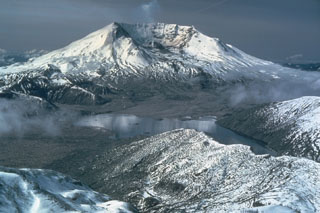Report on St. Helens (United States) — February 1984
Scientific Event Alert Network Bulletin, vol. 9, no. 2 (February 1984)
Managing Editor: Lindsay McClelland.
St. Helens (United States) Lava extrusion stops; deformation and seismicity decline to low levels
Please cite this report as:
Global Volcanism Program, 1984. Report on St. Helens (United States) (McClelland, L., ed.). Scientific Event Alert Network Bulletin, 9:2. Smithsonian Institution. https://doi.org/10.5479/si.GVP.SEAN198402-321050
St. Helens
United States
46.2°N, 122.18°W; summit elev. 2549 m
All times are local (unless otherwise noted)
Increasing seismicity, gas emission and deformation of the composite lava dome culminated in the extrusion of a small new lobe in early February. The extrusion was not observed because of poor weather, but was believed to have started between late 7 and early 8 February (when seismicity decreased sharply from peak levels reached during the evening of the 7th). The roughly circular new lobe, about 140 m in diameter and 25 m thick, spread N from the former apex of the January mound, just E of the dome's summit. The mound, first seen 9 January, had a surface of old material but was probably cored by magma. It had reached its maximum elevation 20 January, then subsided slowly. A new mound, almost as large as the February lobe, formed in the dome's summit crater after 6 February, probably just before the lobe was extruded. Observations of this feature have been limited because it has remained enveloped in vapor, but it appeared to be cored by a highly oxidized monolith or spine rising about 30-40 m from the crater floor and having a similar or slightly smaller width. The USGS estimated that the dome expanded by about 4 x 106 m3 during the period of rapid deformation from late January through early February. The volume of the February lobe was estimated to be about an order of magnitude smaller.
After the end of the February extrusion episode, activity declined to the lowest level since continuous dome growth began in early 1983. From mid-February through early March, deformation on all sides of the dome has been less than 1 cm/day. Although one station moved 5 cm between 3 and 4 March, it was located close to the new lobe and may have been affected by local movement. Seismic energy release, which had increased in early February, dropped abruptly with the sharp decline in the number of events late 7 to early 8 February. Two M 2 events were recorded 10 and 12 February, but there were few earthquakes after the 12th and very little energy release. SO2 emission dropped gradually through February, from 170 t/d on the 7th to slightly less than 100 t/d at the end of the month. Gas-and-ash ejections, which had occurred several times a day in past months, were not observed after 3 February. A wispy plume emitted continuously from the dome 3-7 February deposited a very thin layer of powdery ash nearby, but this had stopped by the end of the extrusion episode.
Geological Summary. Prior to 1980, Mount St. Helens was a conical volcano sometimes known as the Fujisan of America. During the 1980 eruption the upper 400 m of the summit was removed by slope failure, leaving a 2 x 3.5 km breached crater now partially filled by a lava dome. There have been nine major eruptive periods beginning about 40-50,000 years ago, and it has been the most active volcano in the Cascade Range during the Holocene. Prior to 2,200 years ago, tephra, lava domes, and pyroclastic flows were erupted, forming the older edifice, but few lava flows extended beyond the base of the volcano. The modern edifice consists of basaltic as well as andesitic and dacitic products from summit and flank vents. Eruptions in the 19th century originated from the Goat Rocks area on the N flank, and were witnessed by early settlers.
Information Contacts: R. Holcomb, C. Mullins, T. Casadevall, USGS CVO, Vancouver, WA; S. Malone, University of Washington.

